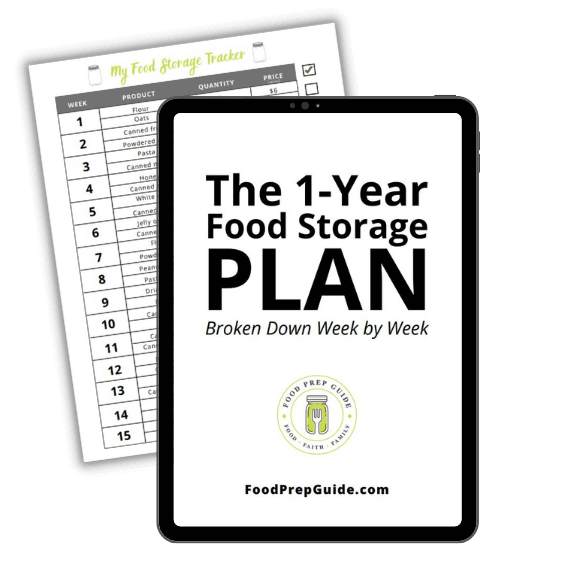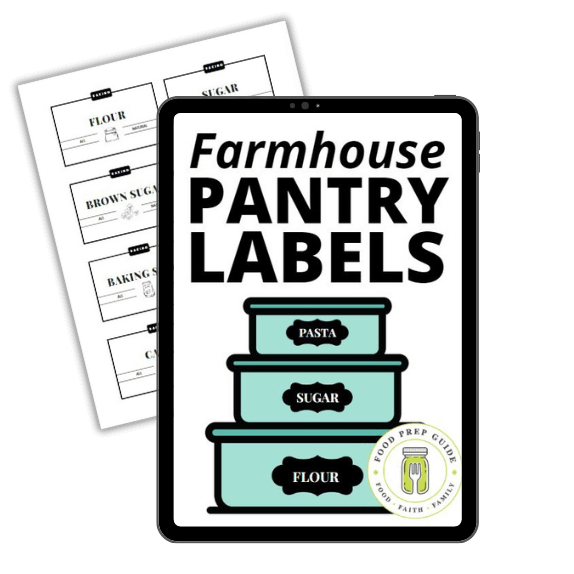One of the most used pantry staples in the kitchen is flour. Whether you use white flour, whole wheat flour, barley, rice, or oat flour, you’ll need to store it properly to keep it safe to eat.
You’ll also want it as fresh as possible so your bread and other baked goods reach optimal tastiness.
The best type of container to store flour is one that protects it from the surrounding environment. Enemies of every type of flour include UV light, excessive heat, insects, and moisture.
Factors to Consider When Choosing the Best Container for Your Flour
There are many different options for storing flour. We’ll talk about a few of them in just a minute. No matter which flour container you choose, it needs to help you meet these storage requirements:
Heat
The temperature at which you store flour is crucial. Ideally, the cooler, the better. The cooler the temperature, the longer your flour will stay fresh.
The preferred temperature to store flour is under 70 degrees Fahrenheit. As a matter of fact, if you can freeze it, that’s even better!
However, most of us don’t have freezer space for huge amounts of flour, especially when foods that must be frozen take priority.
As long as you can keep your flour between 40 and 70 degrees in a pantry or dry goods cellar, it should be cool enough to preserve its freshness a long time.
Light
As we stated, UV light is detrimental to flour storage. This is unfortunate, since glass and plastic containers are suited for storage in so many other ways but are usually clear – good for keeping track of your flour supply, but not so good at keeping out light.
Since the containers can’t protect your flour from damaging light rays, that means you’ll want to protect the clear containers themselves from UV light by storing them in a dark area.
Moisture
Moisture equals mold. The more moisture your flour is exposed to during storage, the more likely you’ll have to throw it out once you open it.
Using airtight lids and moisture absorbers goes a long way toward preventing mold in your flour stores.
Below are containers we’ve found to work best for storing flour, depending on your needs.
Best Budget Flour Container: OXO 4.4. Qt Flour Storage
A great value and one of the best canisters for storing flour properly is this one by OXO.
OXO is unique with its innovative lid that tightly seals with a button. That makes it easy to open with one hand – always appreciated when you’re juggling kitchen tools, oven doors, and messy hands.
Prices pulled from the Amazon Product Advertising API on:
Product prices and availability are accurate as of the date/time indicated and are subject to change. Any price and availability information displayed on [relevant Amazon Site(s), as applicable] at the time of purchase will apply to the purchase of this product.
The OXO container is small enough to store in your kitchen pantry, while large enough to hold an entire 5-pound bag of flour.
Storing the whole bag is necessary, because you do not want to leave leftover flour in the bag. Paper bags attract moisture and pests.
Best Container for Storing Flour in Bulk: Vacuum-Sealed Bags Stored in Rubbermaid Totes
Another option you may not have thought of is Rubbermaid totes.
In my humble opinion, the best storage option for bulk flour is to vacuum seal into bags then store in totes.
The vacuum seal ensures they’re completely airtight. By storing smaller bags inside the totes, you can take out just the right amount to use in the near future. Meanwhile, the remainder stays sealed and protected from light and rodents.
Prices pulled from the Amazon Product Advertising API on:
Product prices and availability are accurate as of the date/time indicated and are subject to change. Any price and availability information displayed on [relevant Amazon Site(s), as applicable] at the time of purchase will apply to the purchase of this product.
Storing Flour Long-Term: Video Tutorial
Here’s a quick video showing this process in action:
Best Container for Long-Term Flour Storage: Mylar Bags Inside 5-Gallon Buckets
If you want to store bulk flour for years to come, you’ll need a container that can keep it safe and fresh for many years.
The best container to store flour long term is a 5-gallon bucket with your flour sealed in mylar bags.
Prices pulled from the Amazon Product Advertising API on:
Product prices and availability are accurate as of the date/time indicated and are subject to change. Any price and availability information displayed on [relevant Amazon Site(s), as applicable] at the time of purchase will apply to the purchase of this product.
Mylar bags are superior for long-term storage, and the bucket will keep the bags from being attacked by rodents.
By storing the containers in a temperature-controlled environment, some food storage experts have kept their flour supplies fresh for 10-15 years using this method!
Best Glass Container for Flour: Anchor Hocking 2.5 Gallon Glass Jar
Of course, glass is also an appropriate and time-proven way to store dry goods. A glass flour container with a tight-fitting lid will keep your flour dry and protected from odors and insects.
One of the best jars for flour storage is this Anchor Hocking 2.5 gallon glass jar. Bonus? If you bake a lot, this jar is attractive enough to keep out on your countertop!
Prices pulled from the Amazon Product Advertising API on:
Product prices and availability are accurate as of the date/time indicated and are subject to change. Any price and availability information displayed on [relevant Amazon Site(s), as applicable] at the time of purchase will apply to the purchase of this product.
This is the type of storage container you would use for your everyday access flour—not for long-term food storage.
Important: Freeze Your Flour Before Storing in Any Container
Okay, we’ve discussed air, moisture, and rodents. Now let’s talk about bugs.
If you’ve ever encountered a weevil infestation in your flour, you’ll never forget it. I still have flashbacks from the Great Weevil Incident of 2010!
Weevils and other insects can get into your flour at any point before you use it—during processing, in the supermarket, or even after it’s in your own house.
These insidious little creatures lay eggs in the flour or in the paper bag it’s packaged in, and hatch after you’ve stored the flour.
You go to all this trouble to keep air and rodents and mold and sunlight away from your flour, only to open a container ruined by flour bugs!
So how do you prevent weevil nightmares?
The best way to keep your flour from being overrun by insects is to freeze it for at least 24-48 hours before storing it. This will kill the eggs and keep them from hatching.
If you’re not able to freeze all your flour, add oxygen absorbers to prevent eggs from hatching or diatomaceous earth to kill insects once they’ve hatched. It will still be pretty icky to open your flour and find dead bugs, but at least they won’t continue their life cycle, and you’ll be able to salvage what’s left by pouring it through a sieve.
If possible, just do yourself a favor and freeze it to keep those nasties from hatching to begin with.
FREE FOOD STORAGE PLAN!

Does gathering and storing a year’s worth of food for your family seem overwhelming and unachievable?
Make it easy with our step-by-step plan. Subscribe to our weekly newsletter & we’ll send it to you FREE!
FAQS
Is it safe to store flour in a plastic container?
It’s definitely safe to use plastic for flour storage. As long as you choose BPA-free, food-safe plastic containers such as High-Density Polyethylene (HDPE), Polypropylene (PP), Low-Density Polyethylene (LDPE), or Polyethylene Terephtalate (PET or PETE). However, you need to protect thinner plastic containers from rodents and other chewing pests.
Does flour need to be stored in an airtight container?
As much oxygen as possible should be kept out of your flour storage. Oxygen speeds up the deterioration of most dry goods, so your flour will stay fresher longer if it’s protected from the air.
That said, if you know you’ll go through an open bag of flour within 3 months, it’s okay if it is not airtight.
How do you keep worms out of flour?
While not exactly “worms,” flour bug larvae aren’t something you want to find in your flour containers. The best way to prevent flour bug eggs from hatching into larvae (“worms”) is to freeze it for at least 24-48 hours—or even up to 3 full days.
Final Verdict: Which Container Is Best For Storing Flour?
The perfect flour storage container depends on many factors, including:
- The space you have available
- The length of time you plan to store it and how often you need to access it
- The amount of flour you need to store
- Your budget
If you’re planning to store a large amount of flour for a very long time (we’re talking 5 years or more), then consider mylar bags and 5-gallon buckets.
However, smaller amounts for less time can be stored in more accessible plastic and glass containers. Just be sure to use sizes that will contain all of your flour without leaving any in the original containers.
Even if you plan to use your flour relatively quickly, freezing it and transferring it from its paper bag immediately is crucial to keeping it fresh and pest-free.
To find the best container for storing flour, consider your needs and choose what will work best for you.















Hi, I see you do not recommend storing flour long term in glass jars. I am wondering why. I store all my dehydrated and bulk foods in half gallon mason jars and vacuum-sealed with the brake bleeder pump. My pantry is a dark room with no windows. I currently have been able to successfully store unopened 10# plastic bags of Wheat Montana glyphosate-free flour in a pail, literally a metal pail with a lid that is not even super lightly fitting. It has lasted just fine for a year at a time. But I want to remove that pail as it is in the way and add the flour storage to the shelves I have all the jars on. Do you think glass would be okay if it is dark and vacuum sealed? Or is there a specific reason you would not use glass jars? Thanks.
I know we’ve already “spoken” over at Youtube, but I wanted to drop the reply here, too, in case someone else has the same question in the future. 🙂
I don’t recommend it strictly for reasons of light exposure degrading the flour over time. However, that doesn’t seem to be an issue with your setup! I think it’d be fine vacuum sealed and stored in the dark room with no windows as you described. 🙂